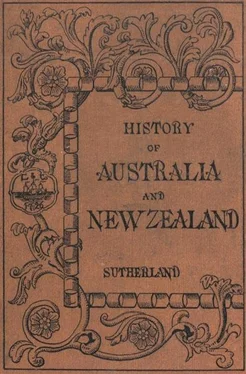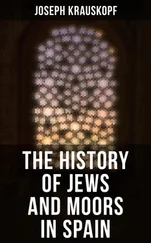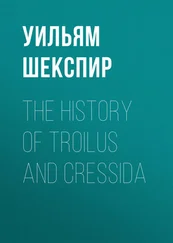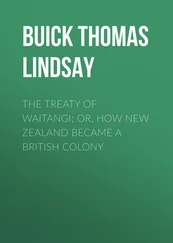12. The Mission Station.—It was in November, 1814, that the Active sailed with the mission colony, consisting of Kendall, King, and Hall, their wives and five children and a number of mechanics; in all twenty-five Europeans, together with eight Maoris. They took three horses, a bull, two cows, and other live stock, and after a quick passage anchored near the north of the North Island. Marsden was with them as a visitor, to see the place fairly started. He was troubled on landing to find that the Ngapuhi were at war with their near neighbours, the Wangaroans, and he saw that little progress would be made till these tribes were reconciled. Marsden fearlessly entered with only one companion into the heart of the hostile tribe; met Tarra, the instigator of the Boyd massacre, and slept that night in the very midst of the Wangaroans. Wrapt up in his greatcoat, he lay close by Tarra, surrounded by the sleeping forms of men and women who, only a few years before, had gathered to the horrid feast. Surprised at this friendly trust, the Wangaroans were fascinated, and subsequently were led by him like children. They were soon induced to rub noses with the chiefs of Ngapuhi as a sign of reconciliation, and were then all invited on board the Active , where a merry breakfast brought old enemies together in friendly intercourse.
The missionaries with twelve axes bought 200 acres of land on the shore of the Bay of Islands. Half an acre was soon enclosed by a fence; a few rough houses were built and a pole set up, upon which floated a white flag with a cross and a dove and the words “Good tidings”; Ruatara made a pulpit out of an old canoe, covered it with cloth, and put seats round it. There, on Christmas Day, 1814, Marsden preached the first sermon in New Zealand to a crowded Maori audience, who understood not one word of what was said, but who, perhaps, were benefited by the general impressiveness of the scene.
In the following February, Marsden returned to Sydney, thinking the mission in a fair way of success. But all was not to be so harmonious as he dreamt; the liberated convicts, who formed the bulk of the crews of sealing and whaling vessels, treated the natives with coarseness and arrogance; the Maoris were quick to revenge themselves, and the murders, thefts, and quarrels along all the shore did more harm than the handful of missionaries could do good. Three or four times they wished to leave, and as often did Marsden return and persuade them to stay. Their lives at least were safe; for Hongi, the Ngapuhi chief, found that they were useful in the way of bringing trade about, but he was dissatisfied because they would not allow guns and powder to be sold by the white men to him and his people.
13. Tribal Wars.—Hongi saw that the tribe which possessed most guns was sure to get the upper hand of all the others. He therefore contrived in another way to secure these wonderful weapons. For in 1820 when Kendall went home to England for a trip Hongi went with him, and saw with constant wonder the marvels of the great city. The sight of the fine English regiments, the arsenals, the theatres, the big elephant at Exeter Change Menagerie, all impressed deeply the Maori from New Zealand forests. He stayed for a while at Cambridge, assisting a professor to compile a dictionary of the Maori language, and going to church regularly all the time. Then he had an audience from George IV., who gave him many presents, and among others a complete suit of ancient armour. For a whole season, Hongi was a sort of lion among London society. People crowded to see a chief who had eaten dozens of men, and so many presents were given him that when he came back to Sydney he was a rich man. He sold everything, however, except his suit of armour, and with the money he bought 300 muskets and plenty of powder, which he took with him to New Zealand. Having reached his home he informed his tribe of the career of conquest he proposed; with these muskets he was going to destroy every enemy. “There is but one king in England,” he said; “there shall be only one among the Maoris.” He soon had a force of a thousand warriors, whom he embarked on board a fleet of canoes, and took to the southern shores of the Hauraki Gulf, where the Ngatimaru lived, ancient enemies of the Ngapuhi, who, however, felt secure in their numbers and in the strength of their great pah Totara. But Hongi captured the pah, and slew five hundred of the unfortunate inmates. The Ngatimaru tribe then retreated south into the valley of the Waikato River, and summoned their men and all their friends; a total of over three thousand were arrayed on that fatal battle-field. Hongi with his muskets gained a complete victory. He shot the hostile chief with his own gun, and tearing out his eyes, swallowed them on the field of battle. Over a thousand were killed, and Hongi and his men feasted on the spot for some days till three hundred bodies had been eaten. The victors then returned, bearing in their canoes another thousand captives, of whom many were slain and cooked to provide a share of the horrid feast to the women of the tribe.
In his bloodthirsty wars Hongi showed great skill and energy. During the two following years he defeated, slaughtered, and ate large numbers of the surrounding tribes, and when a number of these unfortunate people withdrew to a pah of enormous strength, nearly surrounded by a bend of the Waikato River, he dragged his canoes over to that river, ascended it, dashed at the steep cliffs, the ditches and palisades, and once more the muskets won the day. A thousand fell in the fight; then the women and children were slaughtered in heaps. The strong tribe of the Arawa further south had their chief pah on an island in the middle of Lake Rotorua. Hongi with great labour carried his canoes over to the lake. The spear-armed Maoris could do nothing in defence while he shot at them from the lake; and when he assaulted the island, though they came down to the water’s edge to repel him, again there was victory for the muskets. Thus did Hongi conquer till the whole North Island owned his ascendancy. But in 1827 his career came to an end, for having quarrelled with his former friends, the tribe of which Tarra was chief, he killed them all but twenty, but in the fight was himself shot through the lungs; for that tribe had now many muskets also, and a ball fired when the massacre was nearly over passed through Hongi’s chest, leaving a hole which, though temporarily healed, caused his death a few months later. Pomaré succeeded him as chief of the Ngapuhi, and made that tribe still the terror of the island. At one pah Pomaré killed 400 men; and he had his own way for a time in all his fights. But the other tribes now began to see that they could not possibly save themselves except by getting muskets also, and as they offered ten times their value for them in pork and flax and other produce, English vessels brought them over in plenty. The remnant of the Waikato tribe having become well armed and well exercised in shooting under Te Whero Whero, they laid an ambush for Pomaré and killed him with almost the whole of the 500 men who were with him. The other tribes joined Te Whero Whero, and in successive battles ruined the Ngapuhi. Te Whero Whero held the leadership for a time, during which he almost exterminated the Taranaki tribe. He was practically lord of all the North Island till he met his match in Rauparaha, the most determined and wily of all the Maori leaders. He was the chief of a tribe living in the south of the North Island, and he gathered a wild fighting band out of the ruined tribes of his own and the surrounding districts. Many battles were fought between him and Te Whero Whero, in which sometimes as many as a thousand muskets were in use on each side. Rauparaha was at length overcome, and with difficulty escaped across the strait to the South Island, while Te Whero Whero massacred and enslaved all over the North Island, cooking as many as 200 bodies after a single fight. And yet the evil was in a way its own cure, for, through strenuous endeavours, by this time every tribe had a certain proportion of its men well armed with muskets; and thus no single tribe ever afterwards got the same cruel ascendancy that was obtained first by the Ngapuhi and then by the Waikato tribe. But fights and ambushes, slaughters, the eating of prisoners and all the horrid scenes of Maori war went on from week to week all over the North Island.
Читать дальше












